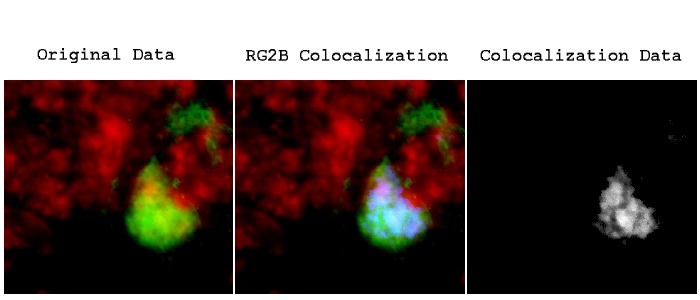| Author: | Christopher Philip Mauer (cpmauer at northwestern.edu) |
| History: |
2004/06/29: First version |
| Limitations: | Only works with RGB images |
| Source: | RG2B_Colocalization.java |
| Installation: |
Download RG2B_Colocalization.java
to the plugins folder and compile it with the "Compile and Run" command.
Restart ImageJ to add the "RG2B_Colocalization" command to the Plugins menu. |
| Description: |
This plugin takes the Red and Green channel values from an RGB image or stack of images, determines
whether or not there is colocalization for a given pixel, and stores the result in the Blue channel
of the image or slice. This method of storage for the colocalization data allows for the easy
appreciation of the presence of colocalized pixels in a sample by superimposing the colocalization
data without corrupting or modifying the original data. To alter the sensitivity of the selection
algorithm, the user can specify the minimum ratio for the pixels in question, as well as the threshold
for the red and green channels. Alternatively, the user can choose to have the threshold values determined
automatically (for each slice if a stack) via the getAutoThreshold() method in the ImageProcessor Class.
The colocalization data can be expressed as the average, max, or min of the corresponding red and green
pixels, or as a saturated pixel (255). The colocalized data can also be displayed in a separate window
as an 8bit or RGB image. If any data was present in the Blue channel of the original image, it will
be replaced by the colocalization data.
Copyright (C) 2004 CHRISTOPHER PHILIP MAUER Permission to use, copy, modify, and distribute this software for any purpose without fee is hereby granted, provided that this entire notice is included in all copies of any software which is or includes a copy or modification of this software and in all copies of the supporting documentation for such software. Any for profit use of this software is expressly forbidden without first obtaining the explicit consent of the author. THIS SOFTWARE IS BEING PROVIDED "AS IS", WITHOUT ANY EXPRESS OR IMPLIED WARRANTY. IN PARTICULAR, THE AUTHOR DOES NOT MAKE ANY REPRESENTATION OR WARRANTY OF ANY KIND CONCERNING THE MERCHANTABILITY OF THIS SOFTWARE OR ITS FITNESS FOR ANY PARTICULAR PURPOSE. The plugin operates on a previously opened image or stack of images, and produces a new image or stack of images. The output image or stack is generated upon completion of processing for all of the input data. Be sure to save the output if desired. The user can specify the following:
|
